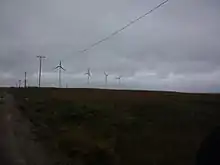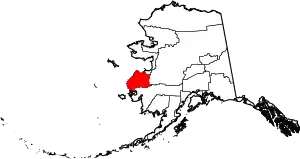Chevak, Alaska
Chevak (Cevʼaq , which means "cut-through channel" in Chevak Cup’ik) is a city in Kusilvak Census Area, Alaska, United States. At the 2010 census the population was 938, up from 765 in 2000.
Chevak
Cevʼaq | |
|---|---|
.jpg.webp) Chevak, August 2013 | |
 Chevak Location in Alaska | |
| Coordinates: 61°31′40″N 165°34′43″W | |
| Country | United States |
| State | Alaska |
| Census Area | Kusilvak |
| Incorporated | October 13, 1967[1] |
| Government | |
| • Mayor | Richard Tuluk[2] |
| • State senator | Donald Olson (D) |
| • State rep. | Neal Foster (D) |
| Area | |
| • Total | 1.14 sq mi (2.96 km2) |
| • Land | 1.14 sq mi (2.96 km2) |
| • Water | 0.00 sq mi (0.00 km2) |
| Elevation | 49 ft (15 m) |
| Population (1940)[4] | |
| • Total | 43 |
| • Estimate (2019)[5] | 1,077 |
| • Density | 942.26/sq mi (363.66/km2) |
| • Demonym | Chevaker |
| Time zone | UTC-9 (Alaska (AKST)) |
| • Summer (DST) | UTC-8 (AKDT) |
| ZIP code | 99563 |
| Area code | 907 |
| FIPS code | 02-13230 |
| GNIS feature ID | 1400219 |
There is a tri-language system in Chevak; English, Cup’ik, and a mixture of the two languages. The people in Chevak speak a dialect of Central Yup'ik, Cup'ik (pr. Chew-pick), and identify themselves as Cup'ik people rather than Yup'ik. This unique identity has allowed them to form a single-site school district, the Kashunamiut School District, rather than joining a neighboring Yup'ik school district. The Cup'ik dialect is distinguished from Yup'ik by the change of "y" sounds into "ch" sounds, represented by the letter "c", and by some words that are completely different from Yup'ik words.
Geography
Chevak is located at 61°31′40″N 165°34′43″W (61.527673, -165.578702).[6]
According to the United States Census Bureau, the city has a total area of 1.2 square miles (3.1 km2), of which, 1.1 square miles (2.8 km2) of it is land and 0.04 square miles (0.10 km2) of it (1.71%) is water.
Wind power

Chevak is powered by four 30-meter-tall wind turbines. The wind generated in Chevak is classified as "Class 6 – Outstanding", and is owned and operated by AVEC (Alaska Villages Electric Cooperative).[7]
Old Chevak (1940)
| Historical population | |||
|---|---|---|---|
| Census | Pop. | %± | |
| 1940 | 43 | — | |
| 2019 (est.) | 1,077 | [5] | |
| U.S. Decennial Census[8] | |||
Chevak first appeared on the 1940 U.S. Census as an unincorporated native village.[9] At the time it was located above the junction of the Keoklevik & Kashunuk Rivers at an altitude of 7 feet. 61°25′56″N 165°27′03″W[10] In the 1940s, residents relocated 9 miles northwest to a new village due to flooding from high storm tides.[11] The old site became Old Chevak and was abandoned and did not report again on the census.
 Original trading post on the Keoklevik River at the old town of Chevak, 2006
Original trading post on the Keoklevik River at the old town of Chevak, 2006 Old town of Chevak on the Kashunuk river
Old town of Chevak on the Kashunuk river
New Chevak (1950-)
| Historical population | |||
|---|---|---|---|
| Census | Pop. | %± | |
| 1950 | 230 | — | |
| 1960 | 315 | 37.0% | |
| 1970 | 387 | 22.9% | |
| 1980 | 466 | 20.4% | |
| 1990 | 598 | 28.3% | |
| 2000 | 765 | 27.9% | |
| 2010 | 938 | 22.6% | |
| 2018 (est.) | 1,075 | [12] | 14.6% |
| U.S. Decennial Census[13] | |||
The new Chevak appeared on the 1950[14] U.S. Census as an unincorporated village, relocated from its original site 9 miles away on higher ground. It formally incorporated as a city in 1967.
As of the census[15] of 2000, there were 765 people, 167 households, and 129 families residing in the city. The population density was 668.6 people per square mile (259.1/km2). There were 190 housing units at an average density of 166.1 per square mile (64.4/km2). The racial makeup of the city was 3.66% White, 90.46% Native American, 0.13% from other races, and 5.75% from two or more races. 0.65% of the population were Hispanic or Latino of any race.
There were 167 households, out of which 64.1% had children under the age of 18 living with them. 41.3% were married couples living together, 20.4% had a female householder with no husband present, and 22.2% were non-families. 19.2% of all households were made up of individuals, and 0.6% had someone living alone who was 65 years of age or older. The average household size was 4.58 and the average family size was 5.38.
In the city, the age distribution of the population shows 51.8% under the age of 18, 8.8% from 18 to 24, 23.9% from 25 to 44, 11.5% from 45 to 64, and 4.1% who were 65 years of age or older. The median age was 17 years. For every 100 females, there were 113.7 males. For every 100 females age 18 and over, there were 113.3 males.
The median income for a household in the city was $26,875, and the median income for a family was $27,375. Males had a median income of $21,875 versus $18,125 for females. The per capita income for the city was $7,550. About 26.7% of families and 29.5% of the population were below the poverty line, including 32.5% of those under age 18 and 13.3% of those age 65 or over.
Notable people
John Pingayak, an actor and educator, won the Milken Educator Awards in 1992 and played an Inupiat whaling captain in the 2012 film Big Miracle, about the rescue of two gray whales in Utqiagvik, Alaska in 1988.[16]
Photo Gallery
.jpg.webp) Chevak buildings, 2014
Chevak buildings, 2014.jpg.webp) Winter at Chevak, 2013
Winter at Chevak, 2013.jpg.webp) Winter Sunrise at Chevak, 2012
Winter Sunrise at Chevak, 2012.jpg.webp) Sunrise at Chevak, 2012
Sunrise at Chevak, 2012.jpg.webp) Chevak buildings, 2014
Chevak buildings, 2014.jpg.webp) Chevak, August 2012
Chevak, August 2012.jpg.webp) Chevak Winter Sunset at 30 below zero, 2012
Chevak Winter Sunset at 30 below zero, 2012 The school (blue), lake, and condemned old school (red)
The school (blue), lake, and condemned old school (red).jpg.webp) Wayne Hill Store, Chevak, 2012
Wayne Hill Store, Chevak, 2012.jpg.webp) Boardwalk at Chevak, 2014
Boardwalk at Chevak, 2014.jpg.webp) Spring in Chevak, 2014
Spring in Chevak, 2014.jpg.webp) Aerial view of Chevak, 2014
Aerial view of Chevak, 2014.jpg.webp) Little Chevak girl bundled up, 2012
Little Chevak girl bundled up, 2012
References
- "Directory of Borough and City Officials 1974". Alaska Local Government. Juneau: Alaska Department of Community and Regional Affairs. XIII (2): 24. January 1974.
- 2015 Alaska Municipal Officials Directory. Juneau: Alaska Municipal League. 2015. p. 42.
- "2019 U.S. Gazetteer Files". United States Census Bureau. Retrieved June 30, 2020.
- "Annual Estimates of the Population for Incorporated Places in Alaska". United States Census Bureau. 2008-07-10. Archived from the original on July 9, 2009. Retrieved 2008-07-14.
- "Population and Housing Unit Estimates". United States Census Bureau. May 24, 2020. Retrieved May 27, 2020.
- "US Gazetteer files: 2010, 2000, and 1990". United States Census Bureau. 2011-02-12. Retrieved 2011-04-23.
- "Wind Resource Assessment" (PDF). Alaska Industrial Development and Export Authority. 2006-05-08. Archived from the original (PDF) on 2011-07-23. Retrieved 2010-09-13.
- "U.S. Decennial Census". Census.gov. Retrieved June 6, 2013.
- https://www2.census.gov/prod2/decennial/documents/33973538v1ch11.pdf
- https://geonames.usgs.gov/apex/f?p=138:3:0::NO:3:P3_FID,P3_TITLE:1407477,Old%20Chevak
- "Geological Survey Professional Paper". 1949.
- "Population and Housing Unit Estimates". Retrieved June 4, 2019.
- "Census of Population and Housing". Census.gov. Retrieved June 4, 2015.
- https://www2.census.gov/prod2/decennial/documents/41601749v2p51-54ch2.pdf
- "U.S. Census website". United States Census Bureau. Retrieved 2008-01-31.
- John Pingayak, Milken Educator Awards, 1992. Retrieved April 25, 2018.
